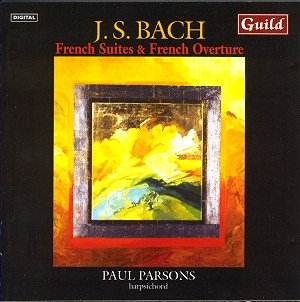It
goes without saying that Johann Sebastian Bach is among the greatest
composers who ever lived. It is simply hard to comprehend how
a single individual could conceive of so much music in so many
different combinations of instruments, not to mention the hundreds
of works he wrote for church choirs. There was a time when he
was obliged to produce a church cantata for each and every
Sunday (198 in all!) – the mind truly boggles.
As
the fairly extensive liner notes in this 2 disc set explain, we
can sometimes lose sight of Bach’s humanity as a result of the
sheer nature of his musical genius, and the great religious choral
works and those for organ, as well as the Well Tempered Clavier,
tend to imply that his great aim was to create works out of the
range of ordinary men. However, as Derek Adlam points out "This
overlooks the fact that stylised dance music formed a very large
part of Bach’s output, and that these works allow us to understand
better the true nature of his humanity and personality."
He goes on to say that suites of instrumental dance pieces were
well established by the 1650s. The principal form was to provide
a core of 4 pieces, each representative of a different national
temperament: Allemande, German in style and serious in content,
Courante, gracefully French, Sarabande, dignified and Spanish,
and a lively Gigue, possibly based on an English dance. To this
core could be added further parts such as Bourees, Minuets, Gavottes
and Polonaises. Given Bach’s supreme understanding of counterpoint
it is not surprising that he elevated these types of works to
new heights in his 3 sets of 6 suites for keyboard.
This
two disc set presents all six of his French Suites plus his French
Overture, BWV 831, and one of his Preludes and Fugues. I was immediately
struck by the beautifully clear sound Paul Parsons achieves from
this instrument which is a recent copy by Adlam/Burnett of a 1638
harpsichord made by Ioannes Ruckers (and which was lent by Richard
and Katrina Burnett from their collection at the Finchcocks Living
Museum of Music – http://www.finchcocks.co.uk)
It is a joy to realise how these skills of period instrument making
are alive and well and practised in many countries today. The
instrument Paul Parsons plays is a wonderful example of these
skills with a truly authentic sound. His refined playing of these
brilliant works makes this a set that will please all lovers of
the harpsichord. As far as I am concerned, however, 2 CDs worth
of this is too much for my musical appetite to digest in one sitting
and I prefer to treat it as less of a feast and more of a buffet,
and simply graze.
Steve
Arloff
see also review by Kirk
McElhearn
